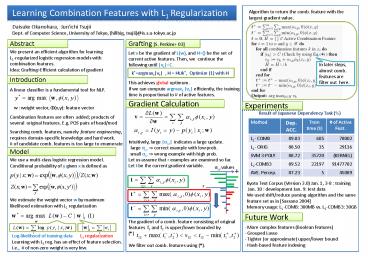Learning Combination Features with L1 Regularization - PowerPoint PPT Presentation
1 / 1
Title: Learning Combination Features with L1 Regularization
1
Learning Combination Features with L1
Regularization
Algorithm to return the comb. feature with the
largest gradient value.
Daisuke Okanohara, Junichi Tsujii Dept. of
Computer Science, University of Tokyo, hillbig,
tsujii_at_is.s.u-tokyo.ac.jp
Abstract
Grafting S. Perkins 03
We present an efficient algorithm for learning
L1-regularized logistic regression models with
combination features. Idea GraftingEfficient
calculation of gradient
Let v be the gradient of L(w), and H be the
set of current active features. Then, we
continue the following until vkltC. This
achieves global optimum. If we can compute
argmaxk vk efficiently, the training time is
proportional to of active features.
In later steps, almost comb. features are filter
out here.
kargmaxkvk , H H?k, Optimize (1) with H
Introduction
A linear classifier is a fundamental tool for
NLP.
Gradient Calculation
Experiments
w weight vector, F(x,y) feature vector
Combination features are often added products
of several original features. E.g. POS pairs of
head/mod
Result of Japanese Dependency Task ()
Searching comb. features, namely feature
engineering, requires domain-specific knowledge
and hard work. of candidate comb. features is
too large to enumerate
Intuitively, large ai,y indicates a large
update. large ai,y ? correct example with low
prob. small ai,y ? wrong example with high
prob. Let us assume that r examples are examined
so far. Let t be the current gradient variable.
The gradient of a comb. feature
consisting of original features f1 and f2 is
upper/lower bounded by () We filter out comb.
features using ().
Model
We use a multi-class logistic regression model.
Conditional probability of y given x is defined
as
ai,y values
Kyoto Text Corpus (Version 3.0) Jan. 1, 3-8
training Jan. 10 development Jan. 9 test
data We used shift/reduce parsing algorithm and
the same feature set as in Sassano 2004 Memory
usage L1-COMB 300MB vs. L2-COMB3 30GB
r
We estimate the weight vector w by maximum
likelihood estimation with L1 regularization
Future Work
- More complex features (Boolean features)
- Grouped Lasso
- Tighter (or approximate) upper/lower bound
- Hash-based feature indexing
Log-likelihood of training data
L1 regularization
Learning with L1 reg. has an effect of feature
selection. i.e., of non-zero weight is very
few.































